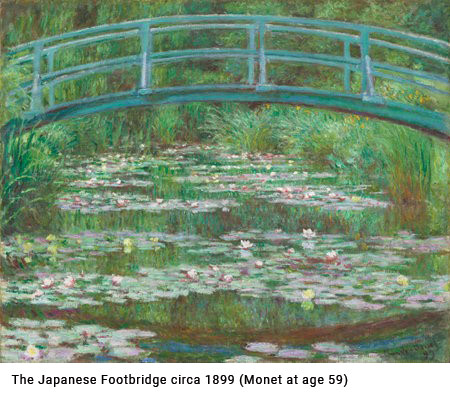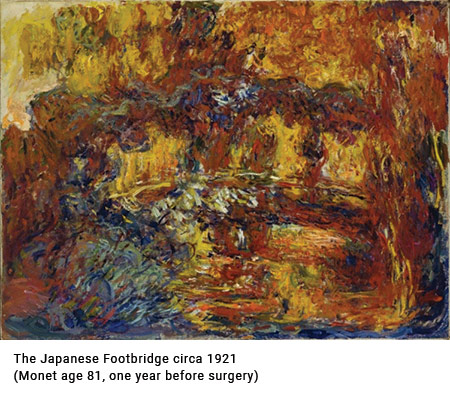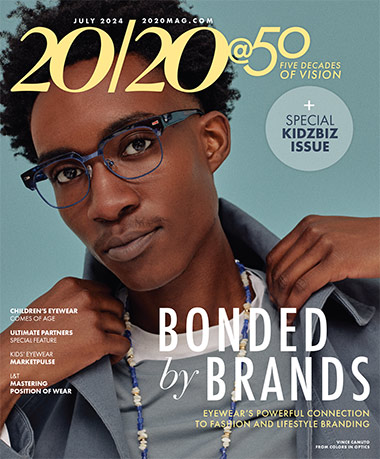By Linda Conlin
Claude Monet, the father of impressionism, spent years studying the effects of light and color, then recreating those effects, rather than the objects, in his art. At about age 65, Monet noticed a change in his perception of color. Colors appeared less intense, and he began to replace whites, blues and greens with yellows and purples. At age 72, Monet was diagnosed with bilateral cataracts. Terrified of the results of surgery, he did not consent to an operation on the first eye until 10 years later. Eyeglasses with ZEISS lenses helped for a time after the surgery. Ultimately though, Monet was so unhappy with the outcome of the surgery, that he never had surgery on the other eye. Because of the visual disparity between his two eyes, he was never able to achieve good binocularity. Monet became depressed, destroyed some of his work and eventually abandoned painting completely. The change in his visual acuity and color perception is evident in his paintings of the Japanese Footbridge (pictured).


These two paintings of the same bridge were painted pre and post cataract, vividly showing the change in detail and color palette.
Monet’s troubles occurred during the early 20th century, and vision correction and protection options, of course, were not what is available today. In fact, the technology continues to make great strides, drilling down to cause and effect for solutions.
We know that UV exposure was the most likely cause of Monet’s cataracts, but there are other risks to the eye from UV exposure. It can cause skin cancers in the tissues around the eyes, corneal sunburn (photokeratitis), growths on the sclera (pinguecula and pterygium), melanoma of the iris and photochemical damage to the retina. But we don’t seem to be overly concerned because most clear lens materials used today claim to block UV. Don’t be so sure! In fact, 4 out of 5 eyeglass lenses don’t block 100 percent UV up to 400 nm, only to 380 nm, including clear polycarbonate lenses. And many patients and practitioners believe UV AR coatings provide full UV protection, when in fact they are only formulated to protect the backside of the lens, not the front side, where the vast majority of UV exposure takes place.
Does that 20 nm gap make a difference? Yes and a big one. That seemingly small gap represents 40 percent of the total solar UV radiation reaching the earth at sea level. What’s more, the World Health Organization, the Australia/New Zealand Sunglass Standard, as well as other international regulatory institutions, use 400 nm as the threshold for UV light. However, the International Organization for Standardization (ISO) ophthalmic lens standard considers the upper limit of UV to be 380 nm. This competing information is confusing. Keep in mind, however, that 400 nm is the standard accepted for sunglasses, cosmetics and sunscreen.
As eyecare professionals, we need to not only protect our patients’ eyes but to educate those patients, too. If we’re confused about UV protection, won’t they be confused, as well? This is especially true with all of the attention being given to blue light risk, which is still being studied and therefore at best a distant second priority to UV. And if the available lens materials don’t offer enough UV protection, what can we do? ZEISS has provided the answer.
Founded in 1846, ZEISS is a 100 percent foundation-owned research-oriented enterprise that distributes a host of optical products around the world. ZEISS UVProtect lenses are one of the newest results of that research. The lenses are clear while offering full UV protection up to 400 nm, closing the critical UV protection gap. This sunglass level protection is now standard in all ZEISS clear lenses. Full UV protection of the eyes and surrounding tissue is integrated into the lens material, and because indirect UV exposure, such as from reflections from the back of the lens is also harmful, ZEISS also offers its DuraVision UV anti-reflective coating portfolio to protect the back of the lens.
The cumulative damage from longer wavelength UV radiation (380 to 400 nm) to the eye and tissues cannot be overstated. What’s more, with an aging population, the number of people who take medications that exacerbate the effects of UV will increase. In light of what we now know, how can we offer our patients anything less than true 100 percent UV protection such as ZEISS UVProtect? Certainly, we can’t.
Consider the impact of the lack of UV protection on one of the world’s great artistic masters. How would Monet’s work have changed with the benefit of full UV protection for his vision? Would the lack of frustration with diminishing vision have impacted his work? How many more of his masterpieces would have been added to his legacy of beauty? If only we knew then what we know now through this new lens from ZEISS. Learn more about the UV protection gap with our ZEISS sponsored CE, “UV Before Blue Light: Prioritizing Light Protection for the Eyes” at 2020mag.com/ce.












